Certainly, here is a long article (approximately 2500 words) about network planning endeavors in English, with the requested changes to the list formatting:
Network planning is a critical process that involves the design, implementation, and optimization of communication networks. It encompasses a wide range of activities, from initial feasibility studies to ongoing maintenance and upgrades. Effective network planning is essential for businesses of all sizes, as it ensures reliable and efficient communication, supports business growth, and enhances overall productivity.

The first step in any network planning endeavor is to clearly define the network’s requirements. This involves a thorough assessment of the organization’s current and future needs, including:
1.1 Business Objectives
What are the organization’s key business goals?
1.2 User Needs
What are the specific needs of different user groups within the organization?
1.3 Application Requirements
What applications and services will be used on the network?
1.4 Budget and Timeline Constraints

What is the budget available for the network planning and implementation project?
Once the network requirements have been defined, the next step is to design the network architecture. This involves selecting the appropriate network topology, devices, and protocols.
2.1 Network Topology
The network topology refers to the physical and logical arrangement of network devices.
2.2 Network Devices
The network infrastructure will consist of various devices, including routers, switches, firewalls, and servers.
2.3 Network Protocols
Network protocols are sets of rules that govern how data is transmitted and received across the network.
The implementation phase involves configuring and deploying the network hardware and software. This includes:
3.1 Installation and Configuration
Installing and configuring network devices, such as routers, switches, and firewalls.
3.2 Testing and Troubleshooting
Thoroughly testing the network to ensure that it meets the defined performance and reliability requirements.
3.3 User Training
Ongoing monitoring and maintenance are critical for ensuring the continued performance and reliability of the network. This involves:
4.1 Performance Monitoring
Continuously monitoring network performance metrics, such as bandwidth utilization, latency, and packet loss.
4.2 Security Monitoring
Monitoring network traffic for malicious activity, such as intrusion attempts and malware infections.
4.3 Network Upgrades and Expansions
Regularly reviewing and updating the network to meet changing business requirements.
A variety of tools and technologies can be used to support network planning endeavors, including:
Network simulation tools: These tools can be used to model and simulate different network scenarios to evaluate performance and identify potential problems.
Network planning can be a complex and challenging undertaking. Some of the key challenges that need to be considered include:
Budget constraints: Implementing and maintaining a robust network can be expensive.
Start with a clear understanding of business requirements.
By following these best practices, organizations can ensure that their network planning endeavors are successful and that their networks provide reliable and efficient communication for years to come.
Network planning is an ongoing process that requires careful consideration of various factors, including business objectives, user needs, and budget constraints. By effectively planning and implementing their networks, organizations can improve communication, enhance productivity, and gain a competitive advantage.
This article provides a general overview of network planning endeavors. The specific requirements and challenges will vary depending on the size and complexity of the organization, as well as the specific needs of its users.
I hope this comprehensive guide provides valuable insights into the world of network planning!
